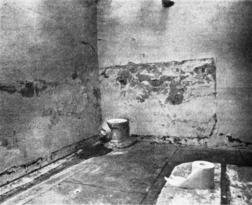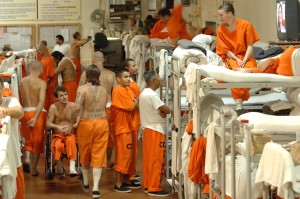 Before the 1950s, prison conditions were grim. Inmates were regularly caged and chained, often in places like cellars and closets. They were also often left naked and physical abuse was common. Mentally ill inmates were held in the general population with no treatments available to them. While the creation of mental asylums was brought about in the 1800s, they were far from a quick fix, and conditions for inmates in general did not improve for decades. A series of riots and public outcry led to the United Nations Standard Minimum Rules for the Treatment of Prisoners, which were adopted in 1955, and conditions in prisons and for offenders improved.
Before the 1950s, prison conditions were grim. Inmates were regularly caged and chained, often in places like cellars and closets. They were also often left naked and physical abuse was common. Mentally ill inmates were held in the general population with no treatments available to them. While the creation of mental asylums was brought about in the 1800s, they were far from a quick fix, and conditions for inmates in general did not improve for decades. A series of riots and public outcry led to the United Nations Standard Minimum Rules for the Treatment of Prisoners, which were adopted in 1955, and conditions in prisons and for offenders improved.
In the 1960s, the common theory on crime included the notion that oppressive societies created criminals and that almost all offenders could become regular members of society given the right resources. As an almost unprecedented crime wave swept across the country, the resources in place at the time did little, if anything, to curb the crime rate that continued to grow well into the 1970s.
At this time, the nation’s opinion shifted to one of mass incarceration. If rehabilitating criminals didn’t work, the new plan was to lock offenders up and throw away the key. Over the next few decades, regardless of whether the crime rate was growing or shrinking, this attitude continued, and more and more Americans were placed behind bars, often for non-violent and minor crimes. The creation of minimum and maximum sentences, as well as the implementation of “three strikes” laws were leading causes behind the incarceration of millions.
 Historically, prisoners were given useful work to do, manufacturing products and supporting the prisons themselves through industry. As laws were passed prohibiting transport of prison-made goods across state lines, most goods made in prisons today are for government use, and the practice itself has been in decline for decades, leaving offenders without any productive activities while serving their sentences.
Historically, prisoners were given useful work to do, manufacturing products and supporting the prisons themselves through industry. As laws were passed prohibiting transport of prison-made goods across state lines, most goods made in prisons today are for government use, and the practice itself has been in decline for decades, leaving offenders without any productive activities while serving their sentences.
Currently, prisons are overcrowded and underfunded. In 2008, 1 in 100 American adults were incarcerated. Estimates vary, but it can cost upwards of $30,000 per year to keep an inmate behind bars. The costs of healthcare for inmates, who often suffer mental health and addiction issues, grew at a rate of 10% per year according to a 2007 Pew study. Programs for the incarcerated are often non-existent or underfunded. Recidivism rates are through the roof, with one Bureau of Justice Statistics study finding that more than 75% of released inmates were arrested again within five years.
 As the number of inmates in American prisons continues to grow, citizens are increasingly speaking out against mandatory minimums for non-violent offenses as well as prison overcrowding, health care, and numerous other issues facing the large incarcerated population in this country. CPR’s mission involves improving opportunities for inmates while incarcerated, allowing for an easier transition into society once released, with the ultimate goal of reducing recidivism throughout the current U.S. prison population.
As the number of inmates in American prisons continues to grow, citizens are increasingly speaking out against mandatory minimums for non-violent offenses as well as prison overcrowding, health care, and numerous other issues facing the large incarcerated population in this country. CPR’s mission involves improving opportunities for inmates while incarcerated, allowing for an easier transition into society once released, with the ultimate goal of reducing recidivism throughout the current U.S. prison population.
